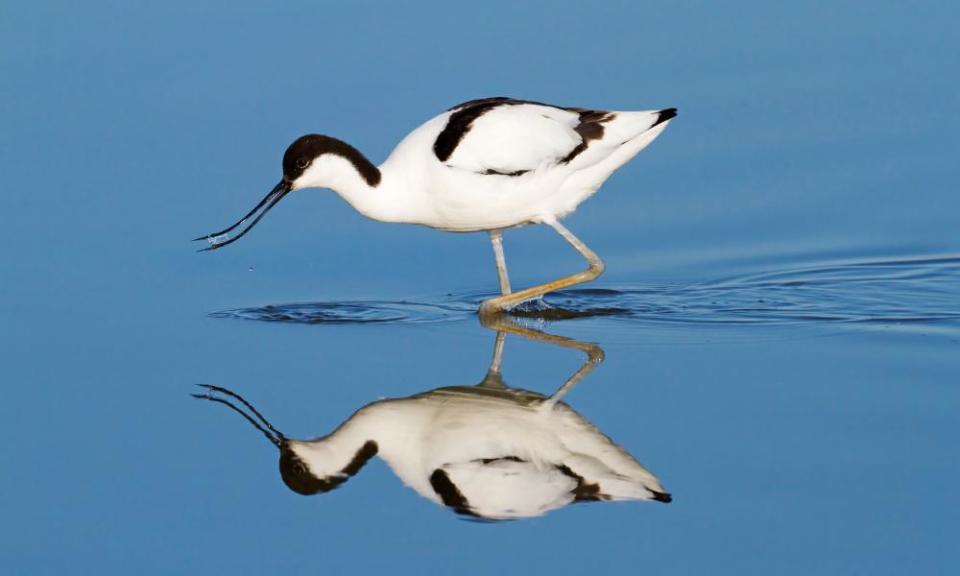How London’s new Elizabeth line has created a sanctuary for birds
London’s new Elizabeth line will allow commuters to start taking high-speed trains under the city this week, on part of a 73-mile route that stretches from Reading in the west to Shenfield in the east. They will not be the first travellers to enjoy the benefits of the new line, however.
On Wallasea Island in Essex, thousands of birds have already taken advantage of the £19bn rail project – on a mosaic of lagoons, islands, and bays that have been created out of 3.5m tonnes of earth that were dug up during construction of its new stations and 13 miles of twin tunnels.
Avian visitors to this newly constructed nature reserve, run by the Royal Society for the Protection of Birds, include avocets, spoonbills, black-tailed godwits and little egrets. Hen and marsh harriers have appeared in winter while wigeon, teal and plover have also frequented the site.
For good measure, I spotted yellow wagtails, oystercatchers, lapwings, black-headed gulls and reed bunting on my visit last week. Brown hares scampered through the long grass while skylarks shrilled above the flat, uninterrupted Essex landscape.
This is a nature lover’s paradise – and remarkably it has been created out of the detritus of one of the UK’s most complex, expensive, crisis-afflicted engineering projects of recent years: Crossrail, an undertaking whose price tag rose from £15bn to £19bn and whose opening on Tuesday will take place four years later than originally scheduled.
“Massive amounts of soil were dug up from below the streets of London during tunnelling needed to create the Elizabeth line,” said Rachel Fancy, site manager of RSPB Wallasea Island. “That material was given to the RSPB, allowing us to create our Jubilee Marsh, the cornerstone of our new reserve.”
The Jubilee Marsh is made up of more than 160 hectares (400 acres) of mudflats, lagoons, marshes, fish pools and grasslands where birds can catch food and make nests. Crucially, these features have been built in a way that best protects them against the rising water levels triggered by global heating. “The trick is to create long, gently rising shores that are not rapidly inundated when water levels rise,” added Fancy. “And it was the 3.5m tonnes of soil we got from Crossrail that helped us to do that.”
Wallasea Island lies on the confluence of the rivers Crouch and Roach near the town of Burnham-on-Crouch, and was originally a patchwork of saltmarsh islets that were drained, over the centuries, to create a farm where wheat, rape and barley were grown. Most of the land lies below sea level, however, and the fields had to be protected by a defensive sea wall. “By the beginning of the 21st century the wall was in need of repair and the farm owner wanted to sell,” said Fancy. “We agreed on an option to buy the land.”
Wallasea was considered to be of special importance because Essex – once a haven for wildlife – has seen more than 90% of its wild coast disappear in the past 400 years, removing habitats for waders and wildfowl that wintered in the area, and eradicating places for nesting in summer.
Then plans were prepared for Crossrail. Sustainability clauses were built into the contracts to build the line, leading managers to offer the RSPB soil that would help it develop a specially sculpted reserve at Wallasea. “Our partnership with RSPB was a key part of Crossrail’s sustainability strategy,” said Mark Wild, Crossrail’s chief executive. “We are really proud that Jubilee Marsh is helping to combat the threats from climate change and coastal flooding.”

Seven million tonnes of soil were eventually excavated from the depths of London during the building of the Elizabeth line and around half of this was delivered, by river, to Wallasea Island. A total of 1,528 shipments were made and a huge conveyor belt was constructed on the island to carry the soil from the shore to a central depot – from which a fleet of dumper trucks transported it to the edge of the new reserve. Here it was carefully layered to create an undulating landscape.
“Then the sea wall was deliberately breached at three carefully selected points,” said Fancy. “These breaches had to be carried out – simultaneously – at low tide. Then as the tide rose later that day, the water began to pour in and formed the islands and lagoons of Jubilee Marsh. “If we had simply breached the sea wall, we would have merely allowed a lake to form, but the soil from Crossrail allowed us to create a network of saline lagoons and islands. It made all the difference.”
The result has been the creation of a thriving wetland where tens of thousands of migratory birds have already taken up board and lodging. More than 150 pairs of avocets bred here last year, making Wallasea – in its brief years of existence – one of the country’s largest colonies of these distinctive black and white waders, a bird that only recently hovered close to extinction in the UK. Other species that have arrived in numbers include plover, bar-tailed godwit, knot and shelduck. “It’s already getting busy out there and that is very encouraging,” said Fancy.

 Yahoo Movies
Yahoo Movies 